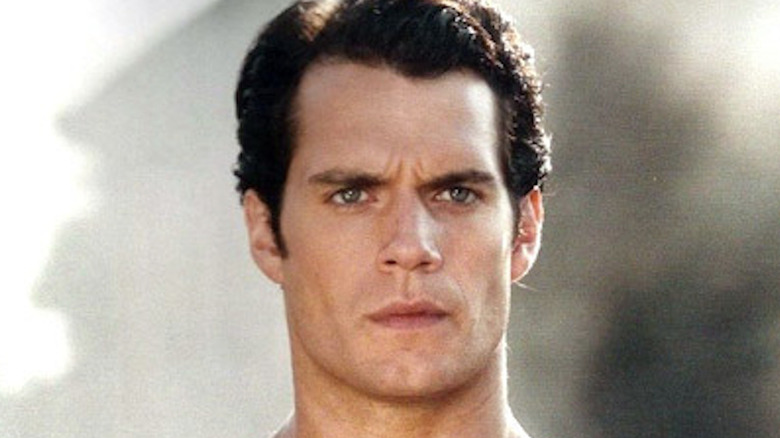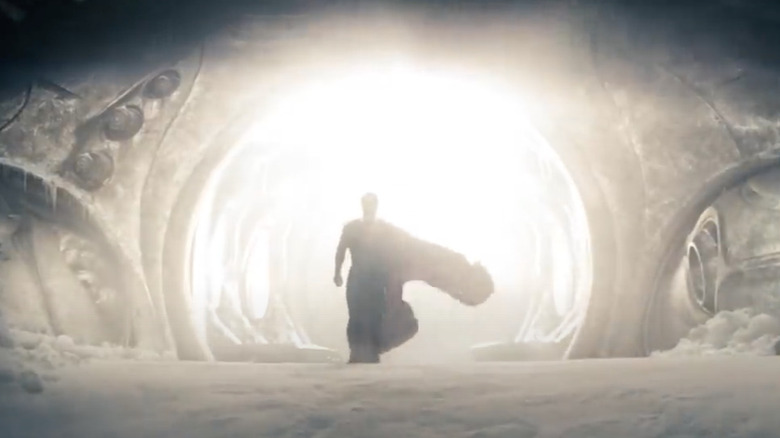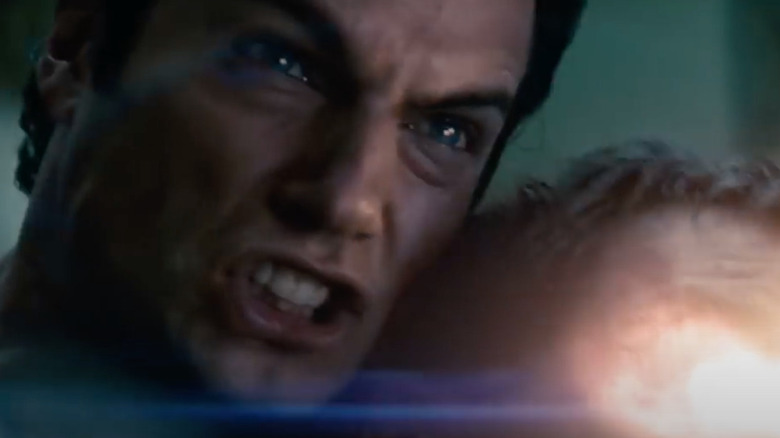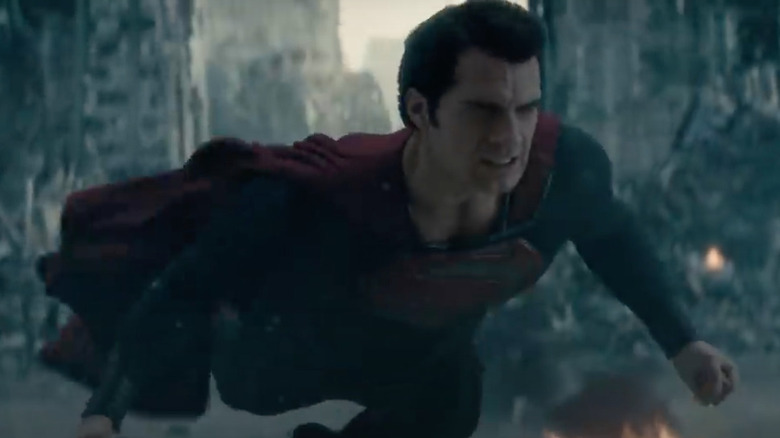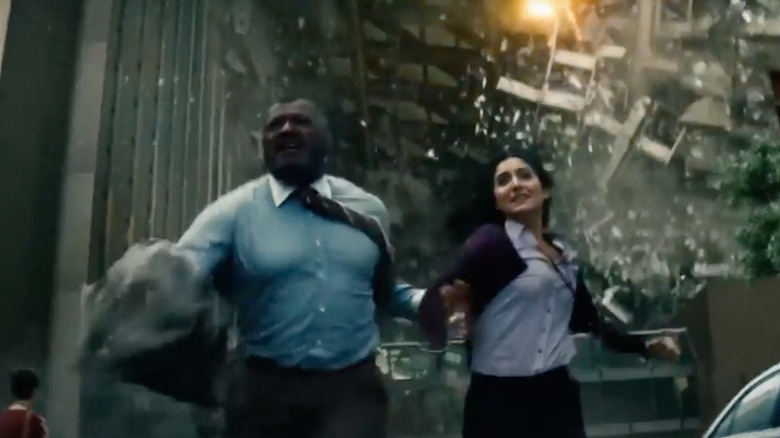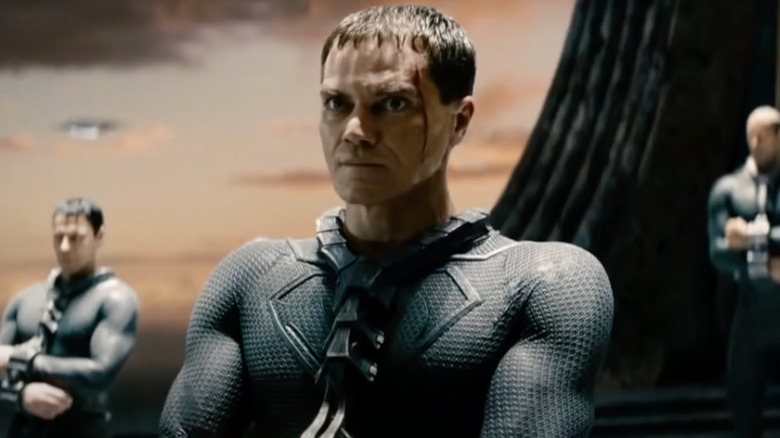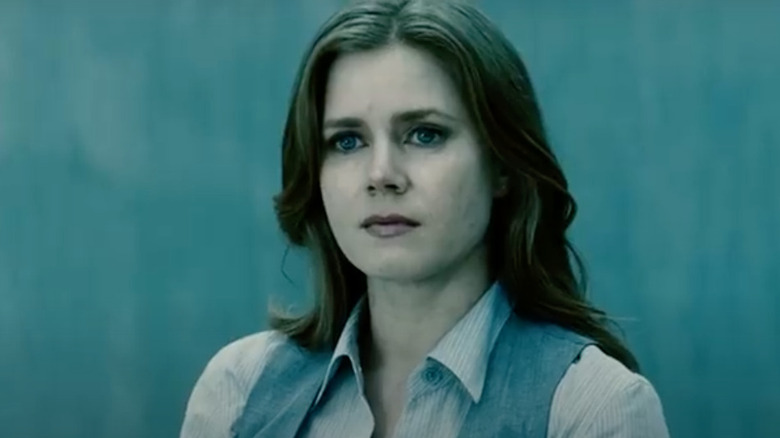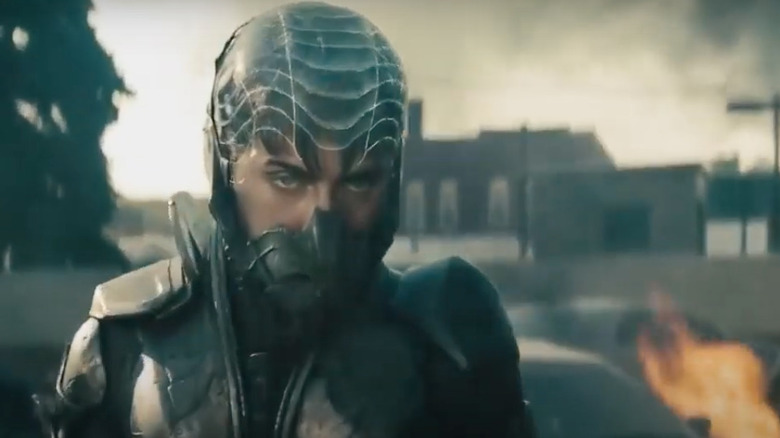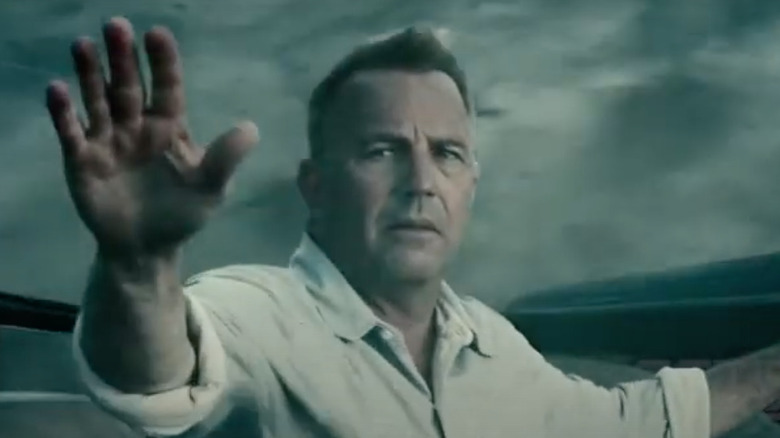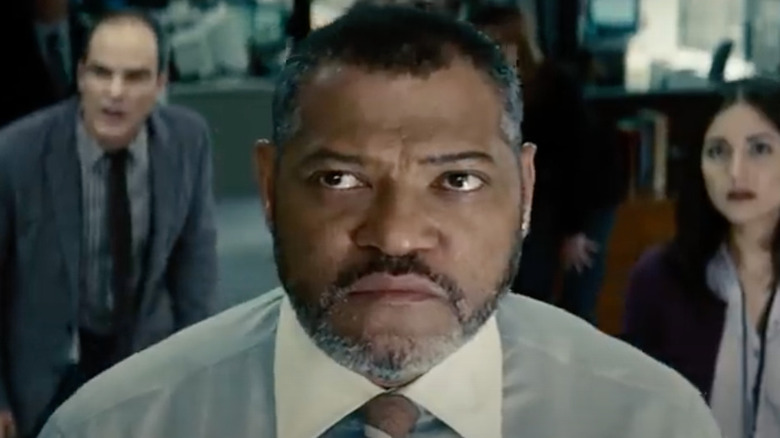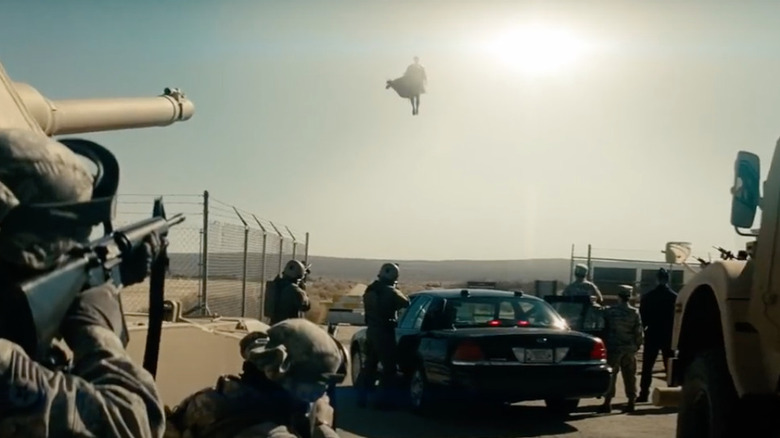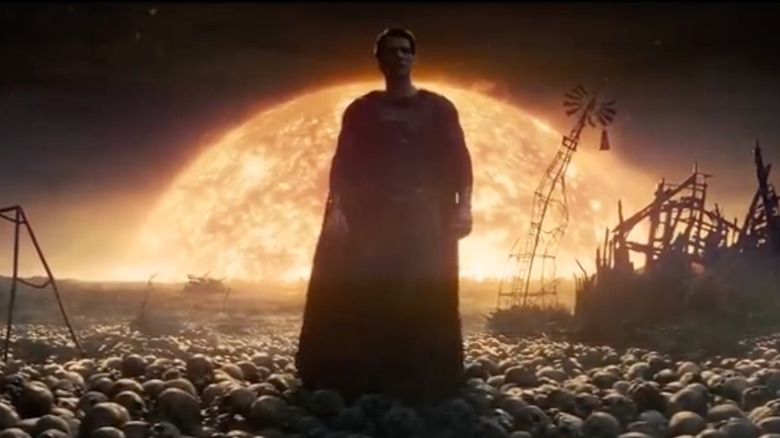The 6 Best And 6 Worst Things In Man Of Steel
In kicking off Zack Snyder's take on the DC universe, 2013's "Man of Steel" had a lot riding on its broad shoulders — and was destined from its first day of filming to be viewed through a particularly harsh lens. Nearly a decade later, with the smoke cleared on its smoldering metropolis, what remains is a thrilling if flawed film that laid the foundation for its slow-mo-loving filmmaker's dark takes on Supes, Batman, and the rest of the Justice League.
Checking in with Rotten Tomatoes, "Man of Steel" still hovers around the 50 percent mark, serving as a reminder of how evenly the film seemed to divide critics. With a somber tone, brutal action sequences and a hero whose god-like similarities may have occasionally felt uncomfortably explicit, the film leapt to the top of the box office in its opening weekend in a single bound, only to fizzle out quickly, with a massive -61% second week drop-off proving to be its kryptonite. While the film eventually grossed $667 million worldwide, its final tally paled in comparison to Marvel's typical releases, kicking off the DCEU with something of a thud.
To this day, "Man of Steel" remains divisive — successful enough to spawn two follow-up films (including the controversial "Zack Snyder's Justice League"), ranked number 23 on the list of all-time best-selling Blu-ray titles in the United States, yet seen by many as a missed opportunity. Taking a look back now at the best and worst elements of the film, it's a bit like gawking at Clark Kent — there's something familiar in there, something we're all drawn to, yet but behind those eyeglasses is a facade that can prove unsettling.
BEST: Hans Zimmer's Score
With "Man of Steel," composer Hans Zimmer created a modern score for Superman that embodied this new, Henry Cavill iteration of the character. It was no easy task considering he was following in the footsteps of John Williams, whose theme for Richard Donner's "Superman: The Movie" ranks amongst the most recognizable film scores of all time. Zimmer accomplished the mission, resulting in a musical artistry tonally different than Williams' work, yet every bit as heroic.
"The challenges of creating a Superman score are daunting because Superman is so iconographic," Snyder said in a statement to Rolling Stone in 2013. "I really feel like what Hans created is perfect. Subtle and stirring, epic and commanding. Honestly, Hans crushed it."
Said Zimmer of his work in a 2013 interview with the podcast WNYC Studios: "If you think about the Dick Donner and John Williams version, they declare themselves in the first note. This is a superhero. I kept thinking, we know he's a superhero, but wouldn't it be interesting if we did it the other way around? How can a stranger in a strange land become part of humanity?"
Zimmer's score received a heap of award nominations, yet left some critics (including The Guardian) feeling underwhelmed. Regardless, the soundtrack was not content to simply re-hash the old themes (much like Bryan Singer's 2006 "Superman returns" had), instead declaring a new direction that fit Snyder's style, much like Zimmer's music did for Christopher Nolan's "Dark Knight" trilogy.
WORST: Superman Breaks Zod's Neck
Superman's confrontation with Zod is a thrilling moment, with two godlike warriors tossing one another through buildings, zipping around the skies like jets, tossing vehicles, and even battling atop one of Bruce Wayne's orbiting satellites. Eventually, the fight comes to a head when Superman chucks Zod into a building full of people and the villain proceeds to use his heat vision to threaten a nearby family. Superman's pleas fall on deaf ears, forcing the boy in blue to take action and snap Zod's neck. He then screams in agony at the loss of his fellow Kryptonian — and perhaps, his own idealistic innocence.
"[It] is also all about him ending up alone," Zack Snyder said during a digital watch party for the film. "We can debate forever whether Superman would kill Zod. But the real question is his legacy. He's choosing. He's choosing us. He's so hurt. He's torn a piece of himself out."
While Snyder clearly had his reasons, it's all a little too much too soon. This is the type of monumental moment that should have occurred two or three films down the line, after Superman had been better established. With the Man of Steel choosing to wipe out his own species just days after he learned how to fly, it elevated the character to a level of darkness before audiences had the time to become accustomed to the light.
BEST: Henry Cavill's Superman
The late Christopher Reeve left such an incredible mark as cinema's Superman that it was hard to fathom anyone successfully donning the blue tights and red cape ever again — for acknowledgement of this seemingly insurmountable obstacle, look no further than Brandon Routh, who in 2006 collaborated with Singer to not so much succeed Reeve as channel his performance.
Enter little known Henry Cavill, whose credits prior to "Man of Steel" included parts in under-seen films like "Stardust" and "Immortals" and the TV series "The Tudors." The actor, while occasionally a little wooden with his delivery, fit both the suit and the role of the Last Son of Krypton, capturing the hero's earnestness and physicality in impressive manner.
"Becomingly modest in the character's low-key early scenes and gradually reveling in his power," wrote The Hollywood Reporter's Todd McCarthy in 2013, "Cavill has a pleasing presence that makes him easy to accept, as Kal-El accepts the extraordinary fate that has been prescribed for him."
Indeed, while much of "Man of Steel" centers around Kal-El's meditative, often solitary quest to find his place in the universe (a contrast from Reeve's golden boy, frequently played for laughs and breezy hero worship), Cavill managed to strike an aura of humanity. His Superman is built on a foundation of pain, promise, anger, and hope — which also makes it easier to understand why he comes to sympathize with and want to defend us earthlings.
WORST: Destruction of Metropolis
Following the disappointing box office haul of 2006's "Superman Returns" (criticized for a sluggish pace, lack of action and meandering storyline), Warner Bros. and Zack Snyder rebooted the iconic hero with a fierce vengeance. "Man of Steel" wastes no time leaping right into the action, with Krypton's destruction, an explosive oil rig sequence, and an extended third act that sees Zod attempting to terraform the planet using a machine that practically levels Metropolis. Innocent civilians die by the thousands during the cataclysmic event as a result of the chaos — exploding jets, falling skyscrapers, and a black hole that seemingly sucks in everything in close proximity. "Man of Steel" might just have the highest body count of any non-"Infinity Wars" superhero movie.
Snyder goes for broke with the climax, but loses an important aspect of Superman's character while doing so: his humanity. Destruction and death abound to the point of exhaustion, leaving audiences clinging to their seats as the bombastic sound design and relentless flurry of CGI spectacle pounds their brains into oblivion. There are certainly those who appreciate the madness — you can't fault Snyder for his ambition — but in this case, less probably would have amounted to a lot more.
BEST: Michael Shannon's Zod
Although not as big a mountain to climb as Reeve's Superman, Shannon's take on General Zod similarly had big shoes to fill — after all, Terence Stamp's iconic "kneel before Zod" work in the original Reeve films introduced the character to most moviegoers.
Shannon wisely embraced a uniquely more modern, ruthless take on the supervillain, one that not only seeks power, but is driven by an intrinsic-if-misdirected desire to save the people of Krypton. While the logic of destroying a planet full of innocent civilians to spite a former enemy might be questionable (especially considering the many options lingering about the galaxy), there's something refreshingly different about a villain whose actions stem from duty rather than lust for power. At film's end, he kneels (ironically enough) on the dust of his fallen comrades and explains to Superman: "I exist only to protect Krypton. That is the sole purpose for which I was born. And every action I take, no matter how violent or cruel, is for the greater good of my people."
In many respects, Shannon's character has little choice but to act on the orders imprinted on him at birth. As such, he's not a bad man, just a warrior fighting on the wrong side. Thanks to the actor's careful performance, viewers empathize with Zod as much as they fear him — and understand his motivations, even while seeing the character as a lost cause.
WORST: Amy Adams as Lois Lane
Amy Adams remains one of the finest actors of the modern age, a solid A-lister capable of pulling off a wide range of performances in films such as "Junebug," "Catch Me If You Can," "American Hustle" and "The Fighter."
She felt perfectly cast as intrepid reporter Lois Lane (quite a bit more than, say Kate Bosworth), and brought quite a bit to the role. Unfortunately, "Man of Steel" doesn't know what to do with this version of Lois; frequently depositing the character in increasingly ludicrous situations, she seems as essential but uninvolved in Superman's story as his cape or boots.
The "Man of Steel" script even goes so far as to place her aboard a military aircraft in the third act, when all logic dictates her staying as far away from the action as possible — after all, she's a reporter, not a fighter. Her half-baked romance with Superman isn't given the time it requires and ultimately falls flat, while the plot armor she enjoys throughout much of the film generates enough eye rolls to make your head hurt.
Lois would be better utilized in subsequent sequels, namely "Batman v Superman: Dawn of Justice" and "Zack Snyder's Justice League," where Adams' dramatic chops were on effective display. "Man of Steel" stretches the character too thin, leaving her feeling more like a silly plot device than an actual, complicated human being.
BEST: Smallville Battle
While some critics blasted Zack Snyder's "Man of Steel" for its dark, humorless tone and over-reliance on spectacle, few would argue against the virtues of the Smallville battle that occurs midway through the film; it's an effective piece of comic book action brought to life.
After much build-up, Snyder cuts loose, giving the viewer a superhuman smackdown for the ages as Superman takes on two Kryptonian foes — Faora-Ul (Antje Traue) and Nam-Ek — on a small street in rural America. The three warriors employ trains, helicopters, and other vehicles as weapons, dodging missiles, bullets and laser beams while slicing apart small town Americana in a brute, symbolic show of force.
Viewers watch as Superman uses his heat vision in combat for the first time, witness Faora's brutal strength (she takes on a legion of armed soldiers without breaking a sweat) and revel in Zimmer's pulse-pounding score as it drives the action. Snyder's blending of live action and CGI creates an effectively fluid sequence that deserves mention among the best fight scenes of the comic book movie age.
Sure, Superman probably could have used a little restraint to keep innocent bystanders from harm. But considering this was Kal-El's first foray into action hero territory (and he does save that one helicopter pilot), it's a solid portrayal of an emerging hero.
WORST: Death by Tornado
One of the biggest head scratchers in "Man of Steel" arrived when Jonathan Kent (portrayed by Kevin Costner) wouldn't let his adopted son save him from a tornado.
Jonathan is determined to save the family dog. Yet, he doesn't want to be saved himself, because he wants Clark to keep his super-powers hidden.
All this comes across as both clumsy and unnecessary — audiences have watched Superman fly so fast that he reverses the orbit of the Earth; zipping into a tornado, rescuing his old man and zipping back without anyone noticing in the chaos of the storm feels about as challenging as a normal person picking up their dry-cleaning.
As Jonathan raises his hand in protest, allowing the storm to take him away, it might rank among the dumbest deaths in superhero film history. Any point Snyder is trying to make is all but lost in the collateral damage of yet another CGI-driven action scene.
Compare this moment to the quiet, tender shot of Pa Kent (Glenn Ford) saying "oh no" and keeling over from a heart attack in "Superman: The Movie." Small character beats go a long way in conveying big emotions, and all the CGI spectacle in the world won't ever change that.
BEST: Superman vs Zod
Critics were quick to dismiss the barrage of action Snyder employed in the latter of half of "Man of Steel," with The New Yorker noting: "The destruction wrought on Earth by the malicious Zod is one thing, but when the newly dubbed Superman stands up to his father's killer and Earth's ravager, each zooming chase through the air and each blow landed wreaks horrific destruction."
Those who can stomach such intense violence and carnage (and appreciate it as a likely side effect to two super-powered beings battling it out in close proximity to civilians), however, will appreciate the lengths to which Snyder went to ensure an earth-shattering battle for the ages.
When Superman and Zod take flight following the lengthy battle of Metropolis, every punch, kick and deployed laser beam hits with the force of ten nuclear weapons. Viewers can feel the ferocity and strength of these powerful beings, understanding the threat they pose to humanity if left unchecked.
Is the violence in "Man of Steel" a tad excessive? Perhaps. But Snyder's heroes are gods waging war on a planet consisting of mortal beings. When the audience sees the destruction caused by just a handful of Kryptonians, it's enough to raise the question of whether Superman is Earth's protector, or a harbinger of death. After all, had he not come to Earth as a place of refuge, Zod never would have come here either. It's an added bit of depth that brings more complexity than most comic book films.
WORST: Supporting Cast Underused
"Man of Steel" arrived in theaters chock full of talent. In the months leading up to release, casting news of folks like Costner, Diane Lane (as Ma Kent) and Laurence Fishburne as the new Perry White were celebrated and discussed with much online fanfare — and more thought, apparently, than the "Man of Steel" filmmakers ever cared to invest.
From Russell Crowe to Lane, Costner, Fishburne, Harry Lennix, Richard Schiff and Christopher Meloni, most pop in and out of the film in what amounts to extended cameos as one-dimensional caricatures rather than fully formed characters.
For example, once Crowe's Jor-El enjoys his big moment in the opening scene, he is relegated to a supporting role where he mostly delivers dry exposition. Lane and Costner are more effective as Ma and Pa Kent, but neither has much to do once the action begins, all but vanishing for the second half of the film. Fishburne receives far less screentime than Jackie Cooper did in the Reeve films, while Lennix, Schiff and Meloni mostly function as military types with no discernible personalities.
Even Antje Traue as the menacing Faora-Ul feels underutilized. You never get a sense of what's driving her beyond a strict devotion to Zod, which makes the character far less interesting than the turn of Sarah Douglass as Ursa in "Superman II."
"Man of Steel" devotes its runtime almost exclusively to Superman's personal journey, leaving very little opportunity for other characters to emerge. Even so, a little more development in these supporting roles might have helped smooth over some of the film's bumpier aspects.
BEST: Alien Invasion Angle
One of the more inspired aspects of "Man of Steel" is the alien invasion angle that Zack Snyder and writer David S. Goyer employ in telling their story. In Donner's "Superman: The Movie," the hero is depicted as revealing himself to humanity and being instantly embraced as a protector without question. In Snyder's film, however, Superman's appearance has drastic implications on everything from religion to national security.
What's more, by the time Zod shows up in the second half — hacking into communications to threaten all of humanity — Earth has been put on notice; it has suddenly become clear we are not alone in this universe. In that respect, "Man of Steel" is both a superhero and an alien invasion movie.
These revelations leave the planet's security forces scrambling, as weapons are useless against the Kryptonians, as seen during the climactic battle of Metropolis where jets and military-grade weapons have little effect against Zod's massive force. In fact, the ultimate undoing of the villains comes not through any human defenses, but as a result of their own technology, reworked to send them into the Phantom Zone.
The alien invasion angle that permeates the second half of "Man of Steel" offers a unique perspective from which to view these superheroes; it also remains one of the more inspired flourishes of the film.
WORST: Zack Snyder-isms
Zack Snyder has directed some memorable motion pictures, from "Dawn of the Dead" to "300" to "Watchmen" — all ambitious projects that hit the mark more often than not, packing the viewer's brain with wondrous spectacle that pushed the visual medium forward, if not necessarily dialogue and plot. Unfortunately, for all his imagination and creative gusto, Snyder tends to seep his films in so much violence and darkness that it's hard for an audience to find much worth hoping for.
"Man of Steel" is no exception. Whether it's Lara-El getting eviscerated by a heat wave or Superman drowning in a mountain of skulls, Snyder's superhero epic revels in death and destruction. Thousands die during the climactic third act battle of Metropolis, Superman kills an enemy out of anger, and Zod nearly blasts a family to oblivion with his heat vision just to prove a point.
Such moments would have perhaps landed better if Snyder used them more sparingly throughout his films. Instead, they are largely rendered flat, stuck between endless scenes of large-scale carnage wrought by fury-filled characters who resort to insane amounts of violence to settle their conflicts.
